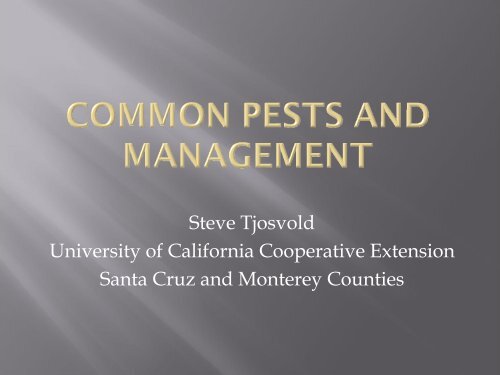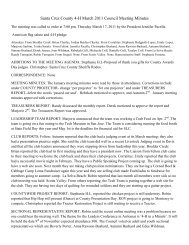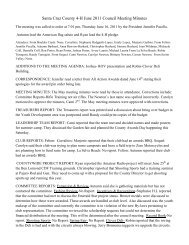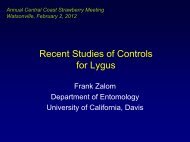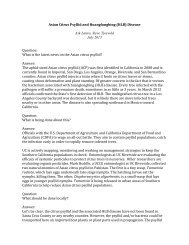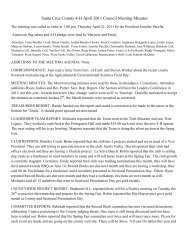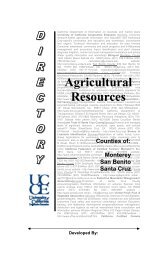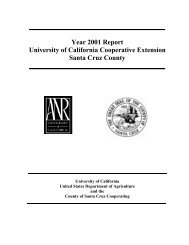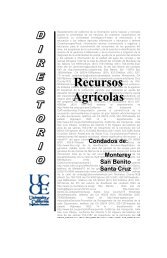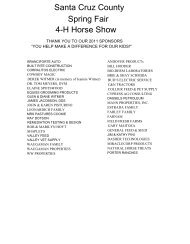Myoporum laetum - Santa Cruz County - University of California ...
Myoporum laetum - Santa Cruz County - University of California ...
Myoporum laetum - Santa Cruz County - University of California ...
Create successful ePaper yourself
Turn your PDF publications into a flip-book with our unique Google optimized e-Paper software.
Steve Tjosvold<br />
<strong>University</strong> <strong>of</strong> <strong>California</strong> Cooperative Extension<br />
<strong>Santa</strong> <strong>Cruz</strong> and Monterey Counties
• <strong>California</strong> oakworm / oakmoth<br />
• Light brown apple moth (LBAM)<br />
• <strong>Myoporum</strong> thrips<br />
• Aphids<br />
• Scales and mealybugs<br />
• Whiteflies<br />
• Thrips<br />
• Management<br />
• How to get more information
Seascape Uplands, September 2007
• Two generations per year<br />
• Outbreak infestations occur irregularly, for<br />
a year or two, followed by several years <strong>of</strong><br />
no apparent damage.
• Chemical control is usually not warranted.<br />
• Natural predators, parsatoids, and pathogens<br />
usually keep in check.<br />
• Chemical control may be warranted if trees<br />
are already weakened or if insect populations<br />
are not tolerable.<br />
• Chemical control: Bacillus thuringiensis (BT),<br />
Spinosad, Pyrethrins, Diflubenzuron.
A native <strong>of</strong> Australia, now a new pest introduced to <strong>California</strong>
• First detected in<br />
Berkeley, <strong>California</strong><br />
Feb. 2007.<br />
• Currently found in 16<br />
federally quarantined<br />
counties.<br />
• Most impacted are in<br />
cooler coastal regions<br />
around the SF and<br />
Monterey Bay Areas.<br />
• Estimated cost <strong>of</strong><br />
control: $70,000,000<br />
(Aug 2010)<br />
Over 2400 square miles are under a State Interior Quarantine<br />
Feb, 2011
Adiantum sp., Aguilegia sp., Amaranthus sp., Arbutus sp., apple (Malus domestica, Malus spp.), apricot (Prunus<br />
armeniaca), Artemesia sp., Astartea sp., Aster sp., avocado (Persea americana), Baccharis sp., black alder/European alder<br />
(Alnus glutinosa), blackberry and raspberry (Rubus spp.), black poplar (Populus nigra), blueberry (Vaccinium sp.), Boronia<br />
sp., Brassica sp., Breynia sp., broad bean (Vicia faba), broadleaf dock (Rumex obtusifolius), Bursaria sp., butterfly bush<br />
(Buddleia sp.), Calendula sp., Callistemon sp., camellia (Camellia japonica), Campsis sp., capeweed (Arctotheca calendula),<br />
Cassia sp., Ceanothus sp., Chinese gooseberry (Actinidia chinensis), Choisya sp., chrysanthemum (Chrysanthemum sp.),<br />
citrus (Citrus spp.), Clematis sp., Correa sp., cotoneaster (Cotoneaster sp.), Clerodendron sp., clover (Trifolium repens,<br />
Trifolium sp.), Cupressus sp., curled dock (Rumex crispus), currant (Ribes sp.), Cydonia sp., Dahlia sp., Datura sp., Daucus<br />
sp., Dodonaea sp., Eriobotrya sp., Eriostemon sp., Escallonia sp., eucalyptus (Eucalyptus sp.), euonymus (Euonymus sp.),<br />
fat-hen (Chenopodium album), Forsythia sp., Fortunella sp., fox’s brush (Centranthus spp.), Gelsemium sp., Genista sp.,<br />
Gerbera sp., gorse (Ulex europaeus), grape (Vitis vinifera, Vitis sp.), Grevillea sp., Hardenbergia sp., hawthorn (Crataegus<br />
sp.), hebe (Hebe spp.), Helichrysum sp., hop (Humulus lupulus), horn <strong>of</strong> plenty (Feijoa sellowiana), ivy (Hedera helix,<br />
Hedera spp.), jasmine (Jasminum spp.), Juglans sp., kiwifruit (Actinidia deliciosa), Lathyrus sp., Lavendula sp.,<br />
Leucodendron sp., Leptospermum sp., Linus sp., litchi (Litchi chinensis), Lonicera sp., alfalfa (Medicago sativa), Lupinus<br />
sp., Lycopersicum sp., Macadamia sp., malabar ebony (Diospyros sp.), Mangifera sp., Melaleuca sp., Mentha sp.,<br />
Mesembryanthemum sp., Michelia sp., Monotoca sp., montbretia (Crocosmia sp.), <strong>Myoporum</strong> sp., oak (Quercus sp.), Oxalis<br />
sp., Parthenocissus sp., peach (Prunus persica), pear (Pyrus sp.), Pelargonium sp., Persoonia sp., Petroselinum sp.,<br />
persimmon (Diospyros kaki), Philadelphus sp., Photinia sp., Pittosporum sp., pine (Pinus muricata, P. radiata, Pinus sp.),<br />
plantain / ribwort (Plantago lanceolata), Platysace sp., Polygala sp., Polygonum sp., poplar and cottonwood (Populus nigra,<br />
Populus sp.), potato (Solanum tuberosum), privet (Ligustrum vulgare, Ligustrum sp.), Pteris sp., Pulcaria sp., Pyllanthus<br />
sp, Pyracantha sp., Ranunculus sp., Raphanus sp., Reseda sp., raspberry and boysenberry (Rubus idaeus, Rubus sp.),<br />
rose (Rosa sp.), Salvia sp., Senecio sp., Scotch broom (Cytisus scoparius), Sida sp., Sisymbrium sp., Smilax sp., Sollya<br />
sp., St. John’s wort (Hypericum perforatum), strawberry (Fragaria sp.), Tithonia sp., Trema sp., Triglochin sp., Urtica sp.,<br />
Viburnum sp., Vinca sp., wattle (Acacia sp.), willow (Salix sp.).
LBAM can be widely distributed in<br />
landscape plantings.
LBAM can be widely<br />
distributed in natural areas
Symptoms at shoot tips<br />
Leaves bound together<br />
with silk-like webs or threads<br />
Leaves chewed<br />
with holes<br />
Leaves distorted
• Five or 6 larva instars. Range in size<br />
from 2 mm to 18 mm (up to 0.75 inch)<br />
• Light to medium green body<br />
• Light yellow-brown head<br />
• Prothoracic shield (1st body segment)<br />
is light green-brown color<br />
• White hairs and light legs.<br />
• Body darker on top, and may have<br />
three distinct darker bands running the<br />
length <strong>of</strong> the body<br />
20mm<br />
http://www.winetitles.com<br />
Many characteristics not the same from one instar<br />
to another. Characteristics more constant when<br />
larva is larger than 8 mm. DNA testing is<br />
necessary for positive identification
Cultural control: weed control and hand-picking insects, inspection <strong>of</strong> plants<br />
Insecticides<br />
• Bacillus thuringiensis kurstaki (DiPel DF and others)<br />
• Spinosyns (Conserve)<br />
• Insect growth regulators (Intrepid)<br />
• Pyrethroids<br />
• Carbamates and organo-phosphates<br />
• Horticultural oils<br />
• Others<br />
Biological control – parasitoids<br />
• UC and CDFA research being conducted on parasitoids <strong>of</strong> <strong>California</strong> native<br />
leafrollers that may also parasitize LBAM.<br />
Sterile Insect Treatment (SIT)<br />
• USDA developing rearing facility for moths. Sterile moths are released in<br />
mass to reduce mating frequency <strong>of</strong> fertile moths.
<strong>Myoporum</strong> <strong>laetum</strong><br />
Photo by UCR CSI
• Introduced 1995 in southern CA.<br />
• A native to Australia or New Zealand,<br />
probably found only on <strong>Myoporum</strong> species<br />
• In <strong>Santa</strong> <strong>Cruz</strong> <strong>County</strong> since at least 2009<br />
• Hosts in CA: <strong>Myoporum</strong> <strong>laetum</strong>, M. debile M.<br />
parvifolium, M. insulare, and M. ‘Pacificum’ (a<br />
prostrate form).<br />
• Minute pirate bug is good predator<br />
• Chemical control with imidicloprid or spinosad<br />
• Prune out infestation. Maintain tree health.<br />
• Remove tree!
The thrips
The thrips<br />
Complete metamorphosis<br />
Tiny “fringed wing” adults<br />
Can transmit viruses<br />
Western Flower Thrips (WFT)
THYSANOPTERA - thrips<br />
Complete metamorphosis<br />
Tiny “fringed wing” adults<br />
Rasping and sponging mouthparts<br />
WFT<br />
Greenhouse Thrips<br />
Western Flower Thrips (WFT)
Impatiens Necrotic<br />
Spotted Wilt Virus
Scales and mealybugs<br />
Grape mealybug<br />
Citrus red scale
Copious<br />
amounts <strong>of</strong><br />
honeydew,<br />
sooty mold<br />
Cast skins<br />
Distortion <strong>of</strong><br />
new growth<br />
Virus<br />
transmission
• Don’t bring home a problem<br />
• Examine plant and roots carefully<br />
• Don’t keep a problem<br />
• Weeds harbor insects and pathogens
• Are they really needed?<br />
• Insecticidal soaps and oils<br />
• BT Bacillus thurengiensis (e.g. Dipel)<br />
• Spinosad (e.g. Conserve, Entrust)<br />
• Insect growth regulators (e.g. kinoprene)<br />
• Multiple applications most likely needed to<br />
eradicate an established infestation<br />
• Good spray coverage<br />
• top, bottom <strong>of</strong> leaves<br />
• surfactant to spread
• Traditional Hardcopy Information<br />
• UC publications<br />
IPM manuals<br />
http://ucanr.org/pubs.cfm<br />
• Digital Information<br />
• UC IPM Online<br />
• Pest Notes<br />
• http://www.ipm.ucdavis.edu/
Monterey Bay Master Gardener Hotline<br />
Monday, Wednesday, and Friday<br />
9 AM to 12 noon<br />
831 763-8007<br />
http://montereybaymastergardeners.org<br />
montereybaymastergardeners.org/


